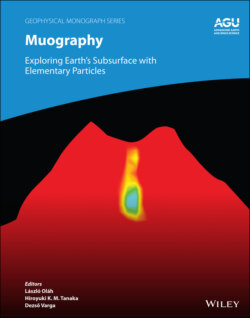Читать книгу Muography - Группа авторов - Страница 37
2.1 INTRODUCTION
ОглавлениеThe internal structure of a volcanic body reflects the eruption dynamics and history of activity. The shallow structure of a volcano controls the eruptive activity. For example, Koyaguchi and Suzuki (2018) reported that whether an eruption forms a pyroclastic fall or flow deposit during an explosive eruption depends on the shape of the shallow crater and conduit. Therefore, density imaging of the shallow volcanic structure can provide insights into such processes.
We highlight some of the muographic observations of volcanoes that motivated our study. Tanaka et al. (2007) muographically imaged the shallow part of the Asama volcano, Japan, using high‐energy cosmic‐ray muons. Although the muographic observation was conducted from one direction, the captured density image revealed the structures of the caprock and the shallow conduit underneath the crater. One‐directional muography yields the density length, which is an integration of density and length along the muon pathway. In the case of one‐directional muography, it is possible to uniquely determine the average density of a mountain body along the muon pathway using a priori information on the mountain topography. However, due to the lack of spatial resolution along the muon path, the results include an uncertainty of uninteresting parts. A simple solution for obtaining additional spatial resolution is to increase the number of observation directions. For example, Tanaka et al. (2010) used two muon detectors to determine the three‐dimensional structure of the shallow conduit of Asama volcano. However, two‐ or three‐directional stereographic muography generally cannot avoid including a priori assumptions, and lacks the spatial resolution to resolve the detailed structure of a volcano. Nishiyama et al. (2014a, 2017), Rosas‐Carbajal et al. (2017), and Barnoud et al. (2021) obtained a three‐dimensional image of the internal structure of a volcano by combining muography and gravity techniques.
The technology for muon detection is improving (e.g., Morishima et al., 2017; Oláh et al., 2018). Nagahara and Miyamoto (2018) studied the feasibility of multi‐directional muon tomography of a volcano based on a simulation using the filtered back projection method. These technological and analytical developments will make multi‐directional muon tomography more feasible. In this chapter, we introduce two methods to reconstruct the three‐dimensional density structure of a body using multi‐directional muographic images. We also evaluate the performance of our methods.
